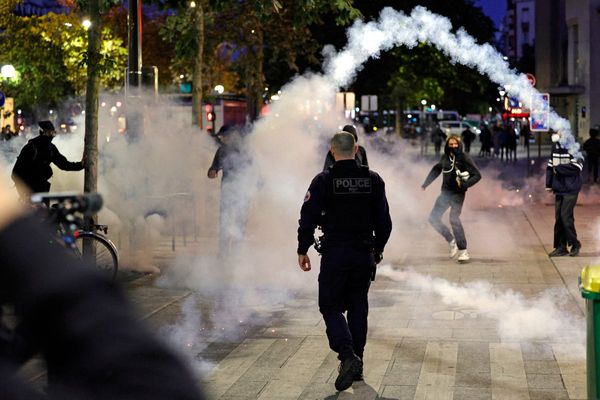
For a decade Hans-Peter Feldmann, who has died aged 82, dropped out of the art world and turned to dealing in antiques: mostly selling tin toys and nautical and medical instruments from a small shop in Düsseldorf. In a way, however, nothing had changed, as Feldman’s art was always about collecting, be it his taxonomical arrangements of found images, his vitrine installations of objects ranging from the slightly creepy (the contents of women’s handbags), or the geeky (stamps).
In 2012, for the artist’s solo exhibition at the Serpentine Gallery in London, Feldmann persuaded six women to sell him the complete contents of their handbags for €500; the assortment of keys, business cards, sunglasses, notebooks, receipts, comfortable shoes, sanitary products and makeup were displayed in museological fashion. Likewise, Stamps with Paintings and Passepartouts (2016), featured long shelves of card-mounted postage stamps from various countries and times, all featuring historical paintings of nudes, mostly female.

Feldmann exhibited piles of hats, pots of fake flowers, photographs of toast, boxes of Milky Way chocolate bars, shelves of ordinary cardboard boxes. In 2017 at the Imperial War Museum he plastered a gallery with hundreds of international newspaper front pages from the day after 9/11.
Not all his work featured numerous elements: he exhibited individual photographic and painted portraits, but which he had interfered with, often cutting out the face of the sitter or altering their eyes into a squint.
When critics tried to link his work to the Pictures generation, including artists such as Richard Prince and Cindy Sherman, who in the 1970s were making a commentary on media saturation, or to appropriation art, a style seen as a successor to Marcel Duchamp’s readymades, Feldmann rejected such conceptualisation. “I have always made very concrete things, whereas conceptual art is only an idea … to me, art is something real, something you need a hammer to do,” he said in a rare interview at the time of his 2010 Malmö Konsthall show. “You go and look at the works, and either you feel something, or you don’t.”
Born in Düsseldorf, Feldmann always refused to give any further biographical information. His father ran a chemist and his “parents were poor so they didn’t have any money to collect anything”, but the job “necessitated a lot of correspondence, invoices etc, which meant I had ready access to different stamps. It was quite an expansive collection compared to that of my friends.”
From the age of five he began to keep scrapbooks of pictures gleaned from magazines and books, carefully cut out. The memory of this, and of his philately, came back to him after he had enrolled at the University of Arts and Industrial Design Linz in Austria and discovered he was not good at painting or drawing. Instead, he started to make little booklets, around 30 in total, compiled between 1968 and 1971 and all titled Bild or Bilder (Picture or Pictures). One featured 11 images of women’s knees, while another a dozen prosaic photographs of aeroplanes. In 1972 he was invited to show them at Documenta 5 in Kassel.

Two years later, in advance of one of Feldmann’s earliest commercial exhibitions, Galerie Paul Maenz in Cologne mailed everyone on its contact list a set of postcards by the artist, over the course of a year, each featuring a found image (among them a horse, a romantic couple) and a caption bearing the month. It was, he said, an anti-consumerist gesture, as each recipient only received 11 of the postcards, rendering every collection incomplete.
In 1977, having had institutional exhibitions at Kunstverein München and Museum Folkwang in Essen, he was invited again to show at Documenta, exhibiting Sunday Pictures, an arrangement of found posters of the period. Another museum show followed in Zurich in 1979, but by this time Feldmann had had enough. “I always made a living from things other than art,” he explained of his break. “Art is a natural function, like coughing, like breathing. You do it to heal yourself.” The remedy this time, however, was to destroy all the work still in his possession and turn down any exhibition invitations that might be forthcoming.

In 1979 he opened a curiosity shop in Düsseldorf’s old town. Among the collectables on sale were thimbles, and these soon proved to be his best sellers. He started to search out more sets and produced a monthly mail order catalogue, all the photographs hand-glued to the pages, sent to enthusiasts internationally. “They were selling like hell, there were so many thimble collectors in the world at that time,” he recalled.
Despite this success, in 1989 the curator Kasper König persuaded him to come back to art with the offer of a show at Portikus, Frankfurt, though Feldmann maintained the shop for a further three decades.
The frequency of the invitations to show in museums and galleries increased. Nonetheless, ever keen on absurd gestures, in 1990 when the then 23-year-old Hans Ulrich Obrist asked him to contribute to an exhibition he was staging in his kitchen, Feldmann made an even smaller show of images inside the curator’s fridge. Two years later Feldmann had his first US survey exhibition at the Guggenheim Museum in New York.
He had a retrospective of his work at Museum Ludwig in Cologne in 2003, and a show at the Arnolfini, Bristol, in 2007. He returned to the Guggenheim in 2011 having won the $10,000 Hugo Boss prize the previous year, withdrawing the prize fund as one dollar bills which he then exhibited at the museum.
He is survived by his wife, Ursula.
• Hans-Peter Feldmann, artist, born 17 January 1941; died 26 May 2023







